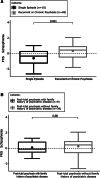Postictal Psychosis in Epilepsy: A Clinicogenetic Study
- PMID: 34288049
- PMCID: PMC9292039
- DOI: 10.1002/ana.26174
Postictal Psychosis in Epilepsy: A Clinicogenetic Study
Abstract
Objective: Psychoses affecting people with epilepsy increase disease burden and diminish quality of life. We characterized postictal psychosis, which comprises about one quarter of epilepsy-related psychoses, and has unknown causation.
Methods: We conducted a case-control cohort study including patients diagnosed with postictal psychosis, confirmed by psychiatric assessment, with available data regarding epilepsy, treatment, psychiatric history, psychosis profile, and outcomes. After screening 3,288 epilepsy patients, we identified 83 with psychosis; 49 had postictal psychosis. Controls were 98 adults, matched by age and epilepsy type, with no history of psychosis. Logistic regression was used to investigate clinical factors associated with postictal psychosis; univariate associations with a p value < 0.20 were used to build a multivariate model. Polygenic risk scores for schizophrenia were calculated.
Results: Cases were more likely to have seizure clustering (odds ratio [OR] = 7.59, p < 0.001), seizures with a recollected aura (OR = 2.49, p = 0.013), and a family history of psychiatric disease (OR = 5.17, p = 0.022). Cases showed predominance of right temporal epileptiform discharges (OR = 4.87, p = 0.007). There was no difference in epilepsy duration, neuroimaging findings, or antiseizure treatment between cases and controls. Polygenic risk scores for schizophrenia in an extended cohort of postictal psychosis cases (n = 58) were significantly higher than in 1,366 epilepsy controls (R2 = 3%, p = 6 × 10-3 ), but not significantly different from 945 independent patients with schizophrenia (R2 = 0.1%, p = 0.775).
Interpretation: Postictal psychosis occurs under particular circumstances in people with epilepsy with a heightened genetic predisposition to schizophrenia, illustrating how disease biology (seizures) and trait susceptibility (schizophrenia) may interact to produce particular outcomes (postictal psychosis) in a common disease. ANN NEUROL 2021;90:464-476.
© 2021 The Authors. Annals of Neurology published by Wiley Periodicals LLC on behalf of American Neurological Association.
Conflict of interest statement
Nothing to report.
Figures




References
-
- Edeh J, Toone B. Relationship between interictal psychopathology and the type of epilepsy. Br J Psychiatry 1987;151:95–101. - PubMed
-
- Scott AJ, Sharpe L, Hunt C, Gandy M. Anxiety and depressive disorders in people with epilepsy: a meta‐analysis. Epilepsia 2017;58:973–982. - PubMed
-
- Hermann B, Jones J, Dabbs K, et al. The frequency, complications and aetiology of ADHD in new onset paediatric epilepsy. Brain 2007;130:3135–3148. - PubMed
-
- Krishnamoorthy ES, Trimble MR, Blumer D. The classification of neuropsychiatric disorders in epilepsy: a proposal by the ILAE commission on psychobiology of epilepsy. Epilepsy Behav 2007;10:349–353. - PubMed
Publication types
MeSH terms
Grants and funding
LinkOut - more resources
Full Text Sources
Medical
Miscellaneous

